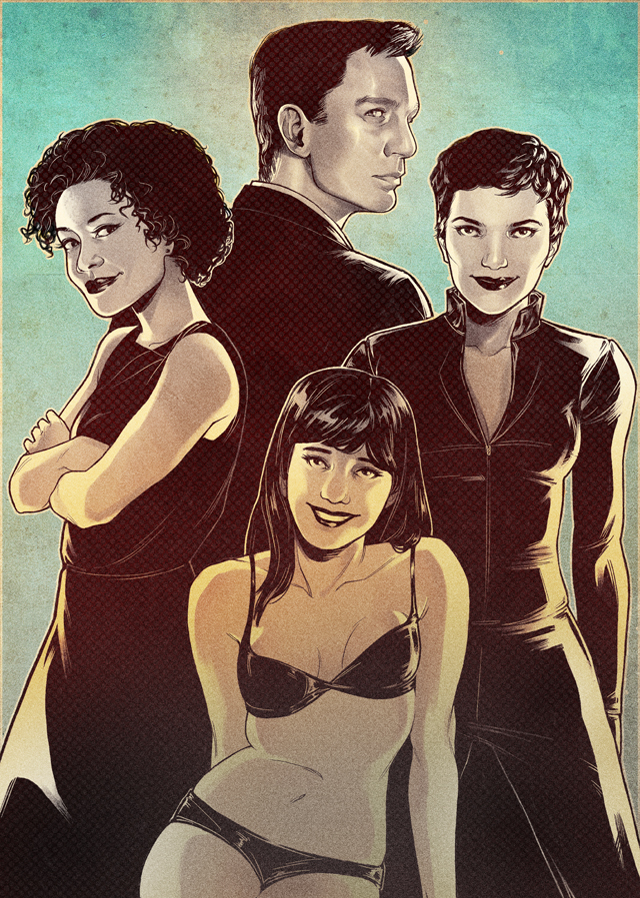
Original illustration by Emilie Majarian for The Mary Sue.
Welcome to Bond Girl, a new series where we’ll be re-watching and re-evaluating every James Bond film until Spectre’s release. Check out previous entries here.
I kind of had to like Thunderball.
Come on! It combines (and quite possibly, may have created) several of my favorite supervillain tropes. You have the shark tank, the cadre of evil villains, and their incompetent henchmen making their plans for world domination just a little more difficult. It’s over-the-top in several places and boring in others, but I’ve got to say that getting into the movie was super easy.
This is the fourth film in the Bond franchise and it’s based on Ian Fleming’s ninth novel, which, in turn, was based on a screenplay written by the trio of Fleming, Jack Whittingham, and Kevin McClory. Fleming’s claim of credit for the book sparked a lawsuit and controversy that lasted into the early 2000s. The plot of the film revolves around Bond’s mission to find two NATO atomic bombs that SPECTRE has stolen and is threatening to use to destroy a city that remains unspecified for most of the film. It’s not the most complicated of plots, truth be told.
Unlike Goldfinger, which had a fair number of moments that I just didn’t like, Thunderball had me hooked from the start. It’s kind of ridiculous and I still can’t get over how it seems as if the world is helpless without James Bond to swoop in and save the day, but I loved it.
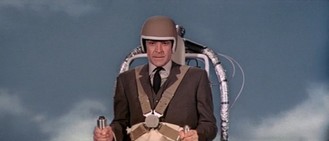
From the start, we knew that this movie was going to be a bit weird. The pre-credits scene has a SPECTRE operative attending his own funeral as his bereaved mistress, an over-the-top fight scene with said operative, and James Bond taking to the skies in a 1960s jetpack.
My only major issue with Thunderball was at the beginning of the film, so let’s just get it over with. After the events of the pre-credits scene, James Bond winds up in an expensive clinic doing some recovery and taking some time off. This is to connect it with the rest of the film, as the place has a sneaky SPECTRE operative there as well, but here’s where it got me bothered:
 There’s an attendant at the clinic who, like Pussy Galore in Goldfinger, initially wants nothing to do with Bond; Molly Peter’s Patricia Fearing is unamused by his flirting and turns him down repeatedly. Not only does Bond ignore this and try to kiss Fearing, but there’s a specific moment where what’s supposed to be subtle and sexy just smacks of Bond forcing Fearing (at first, at any rate) into having sex with him.
There’s an attendant at the clinic who, like Pussy Galore in Goldfinger, initially wants nothing to do with Bond; Molly Peter’s Patricia Fearing is unamused by his flirting and turns him down repeatedly. Not only does Bond ignore this and try to kiss Fearing, but there’s a specific moment where what’s supposed to be subtle and sexy just smacks of Bond forcing Fearing (at first, at any rate) into having sex with him.
After Bond narrowly escapes death on the rack (a physiotherapy machine that really doesn’t look that scary to me), Fearing leads him to the steam room. As he walks behind her, Bond says that, “Somebody’s gonna wish today had never happened.”
This sets Fearing off and she’s worried for her job she asks him if he’s planning on telling her boss.
Following that, the scene goes about as well as you’d expect it to:
James Bond: Well I… I suppose my silence could have a price.
Patricia Fearing: You don’t mean…? Oh no. [she starts shaking her head]
James Bond: [while smiling] Oh yes. [He then draws her into the steam room where it is heavily implied that they have sex]
The next time we see Patricia, she and Bond are in bed and everything is peachy. It’s basically my biggest issue with the Bond series in a nutshell: how we see him con and coerce women into bed with him, and it’s basically never a negative. In fact, James Bond is seen as this incredible stud of a lover, able to change a woman’s mind with one kiss. It kills me.
I read a ton of romance novels, but I’ve never been able to stand that “coercion as seduction” thing that some books – especially the Regency romances – tout as the ultimate in romantic fiction. It’s all about the conquest, the noble hero seeing what he wants from a woman and taking it, turning her mind with a flick of his fingers. After all, the big and buff hero always knows more than the heroine, up to and including her body, desires, and needs.
It’s, well – it’s rape, drenched in romance, and I would be so happy if I could be guaranteed that I’d never have to deal with it in another Bond film. (But alas, I know how likely that is, and it’s not going to happen any time soon.)
Thankfully, because it happened at the start of the film and the movie is two hours long, I had plenty of time to get mad and move on. What helps is that the rest of the Thunderball doesn’t have the same tone in the slightest.
Seriously, the women were the best part about Thunderball. By now, it’s probably pathetically obvious what my weakness is when it comes to these movies, but even when I’m annoyed by a James Bond film, there’s usually at least one female character that I can’t help but adore.
Thunderball has two.
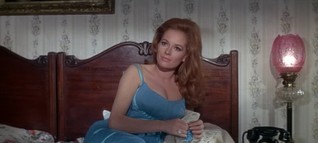 At first glance, Luciana Paluzzi’s Fiona Volpe is the traditional femme fatale. She’s literally drop dead gorgeous and when we first see her, she’s draped over a man while wearing a dress that she’s all but falling out of. It would have been so easy to write her off as a character because of that. Volpe is incredibly seductive as a character and let’s just say that her red hair isn’t the only reason that she puts me in mind of Poison Ivy.
At first glance, Luciana Paluzzi’s Fiona Volpe is the traditional femme fatale. She’s literally drop dead gorgeous and when we first see her, she’s draped over a man while wearing a dress that she’s all but falling out of. It would have been so easy to write her off as a character because of that. Volpe is incredibly seductive as a character and let’s just say that her red hair isn’t the only reason that she puts me in mind of Poison Ivy.
Volpe is deadly and a bit bloodthirsty.
She’s an excellent shot, and she’s in charge.
She is definitely not a minion. Working directly under SPECTRE’s Number Two Emilio Largo, she’s directly responsible for several of the events leading up to the film’s climax including manipulating several deaths. While she isn’t a perfect character (as she still does play into certain negative tropes and is also never seen as Bond’s equal, despite being just as ruthless and clever), she’s such a good character that I couldn’t help how strongly I latched on to her.
I’m so sure that the idea of Volpe’s weaponized sexuality wasn’t intended to be in anyway empowering or inspiring, but I love that she is this seductive force that is more than willing and able to put a bullet in someone that displeases her.
Volpe definitely won me over early on, of course, but what made me wish we could’ve had her as a repeat character was her reaction to James Bond’s claims that he slept with her for the job (reaffirming the idea of women as conquests, of course).
Fiona: But of course, I forgot your ego, Mr. Bond. James Bond, the one where he has to make love to a woman, and she starts to hear heavenly choirs singing. She repents, and turns to the side of right and virtue… [she steps on Bond’s foot] … but not this one! What a blow for you, to have actually suffered a defeat!
In a few seconds she calls Bond out for thinking that he has this magic penis that can sway anyone to his side. She tears into his ego mercilessly and mocks the very idea that he did any of this on purpose. Even when Bond implies that he knew that she was playing him the entire time, she doesn’t act fazed at all.
As this is a Bond movie and, like Volpe says, she’s not swayed to the side of good by Bond’s magical lovemaking, she winds up dying. She’s shot to death by her own henchmen while they try to get Bond. So far, I haven’t liked any of the big villains in the Bond films but, oh, do I adore some of the secondary villains in the earlier films. I’m not saying that I mourned Volpe’s death in the serious sense, but it would’ve been nice to hope that the boys club of SPECTRE might be broken up by her presence. With Largo’s predictable death at the end of the film, Volpe could’ve slipped neatly into the vacuum of power and gained rank in SPECTRE.
I know, I know – this is like ninety percent fantasy that I will probably end up writing myself, but so far we have Pussy Galore and Fiona Volpe as evil or morally gray characters that really needed to show up in later films with more power and agency.
 Now in contrast to Fiona Volpe, Thunderball‘s Bond Girl Domino does kind of turn to the side of good and betray her lover, Emilio Largo, after having sex with Bond. The thing is, that it doesn’t go the way that Volpe would have assumed. After they have sex, Bond tells Domino about the death of her brother on Largo’s orders and her sadness and anger combine to push her over the edge.
Now in contrast to Fiona Volpe, Thunderball‘s Bond Girl Domino does kind of turn to the side of good and betray her lover, Emilio Largo, after having sex with Bond. The thing is, that it doesn’t go the way that Volpe would have assumed. After they have sex, Bond tells Domino about the death of her brother on Largo’s orders and her sadness and anger combine to push her over the edge.
When Bond worries about her and asks her if she’ll be all right, Domino says, “What can he do to me that he hasn’t already done?”
Claudine Auger is such an incredible actress. She takes the scene and blows it out of the water, filling it with heavy emotion until you’re just as angry as she is and just as upset. You come out of it wanting to strangle Largo yourself. (Or at least, I sure did.)
While I didn’t connect to Domino the way that I did Volpe, I enjoyed her as a character, and her interactions with Bond weren’t actually awful. Sure, we got a bit of the low-key sleazy paternalistic interest coming from Bond, but it wasn’t anywhere near as bad as it could have (and has) been. There’s no feeling to me that Domino doesn’t want to be with Bond or that she’s with him because of what he can do for her.
Domino’s relationship with Largo is the problem for me. Largo pretends that Domino is his niece, for pete’s sake. Not only that, but Domino also implies that Laro hurts her and frequently degrades her and with less than twenty minutes to go in the film, Largo threatens her with torture and sexual violence. I actually had to fast forward to that scene because that sort of content is my biggest nope in any media, and it was bad.
I liked Domino because she was strong. We don’t know everything about her – and it’s killing me that there are so many interesting Bond Girls that we never get to know anything about beyond shallow stuff — but she’s a survivor. She’s been through a lot and instead of giving up, she figures out a way to survive. At the end of the movie, she shoots and kills Largo. She gets revenge on her abuser and her brother’s killer.
At the end when Domino puts the spear gun aside, looks at Bond without any remorse on her face, and says, “I’m glad I killed him,” I applauded.
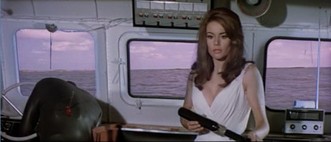 Like I was fawning over Fiona Volpe, but Domino is the character that I’d be if I had to choose.
Like I was fawning over Fiona Volpe, but Domino is the character that I’d be if I had to choose.
Now, the one thing about this movie that stuck with me is how its race problem was a bit different from the problems that the other films have had with race. We have a bit of the familiar brownface and whitewashing with Martine Beswick tanning to a nice crisp brown so that she could pass as a native Bahamian, and, of course, the one man of color with recurring roles is barely a footnote in the film. There’s such a marked absence of race. Aside from the scenes at the Junkanoo, the only people of color we see on Nassau are the help.
The HELP!
And none of them have dialogue.
Didn’t we go through this already in Dr. No?
It’s still incredibly annoying and I almost find myself wishing that they didn’t even bother trying to set the films in exotic locations, since “exotic” to the Eon Production team seems to equal erasing people of color more often than not.
However, there were some definite high points in Thunderball that were lacking in the other three films.
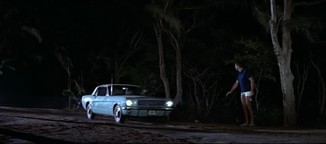 First of all, I only wanted to fight Sean Connery’s Bond once, and it was at the beginning of the film. He was almost back to his charming, attractive self in this film and it felt like a return to the stuff I definitely liked about his Bond. (And his legs – oh his legs – were gorgeous in this film. This has nothing to do with anything feminist or critical or anything but I’m so thankful to the costume department for this film.)
First of all, I only wanted to fight Sean Connery’s Bond once, and it was at the beginning of the film. He was almost back to his charming, attractive self in this film and it felt like a return to the stuff I definitely liked about his Bond. (And his legs – oh his legs – were gorgeous in this film. This has nothing to do with anything feminist or critical or anything but I’m so thankful to the costume department for this film.)
Secondly, the sharks. Oh man. I knew that Sean Connery nearly got attacked by sharks during the filming of the pool scene from watching Everything or Nothing: The Untold Story of James Bond when it was on Netflix. Back then, I adored Sean Connery’s Bond (or at least the hazy memory that I had of him) so I was so upset to find out that he had nearly been shark chum.
But now?
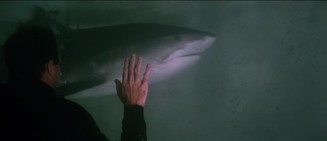
Watching Thunderball and actually being able to pinpoint the moment when one of the sharks in Largo’s pool tries to go after Bond is probably the funniest thing in the world. I’m happy that Sean Connery didn’t get bitten, but, okay, I’m just tickled by the idea that they thought anything would work to keep him completely out of the range from being shark chow.
Thunderball was entertaining. It was a bit boring, and that’s the main complaint that many people have about it, but my sense of humor is warped just enough that I was entertained through some of the worst parts. Is it the film by which I want to remember Terence Young’s directing style? Not really, but I liked it miles better than I did Guy Hamilton’s take on the series, and I found myself back in like with Sean Connery’s Bond.
Here’s hoping that the next Sean Connery film is even better.
What I’m looking forward to:
Okay, I already have the 1967 version of Casino Royale in the queue for streaming. I can’t compare it to the 2006 version of the film until after I do the review for it in the future, but I’m excited to be taking notes. I know nothing about this version of James Bond (I didn’t even know it existed until when I was doing the research for this series), so I’m eager to look at how David Niven rates as James Bond.
Stitch writes about comics, nerd history, and ridiculous romance novels when not working frantically on her first collection of short stories. Find her on her blog or on Twitter.
—Please make note of The Mary Sue’s general comment policy.—
Do you follow The Mary Sue on Twitter, Facebook, Tumblr, Pinterest, & Google +?



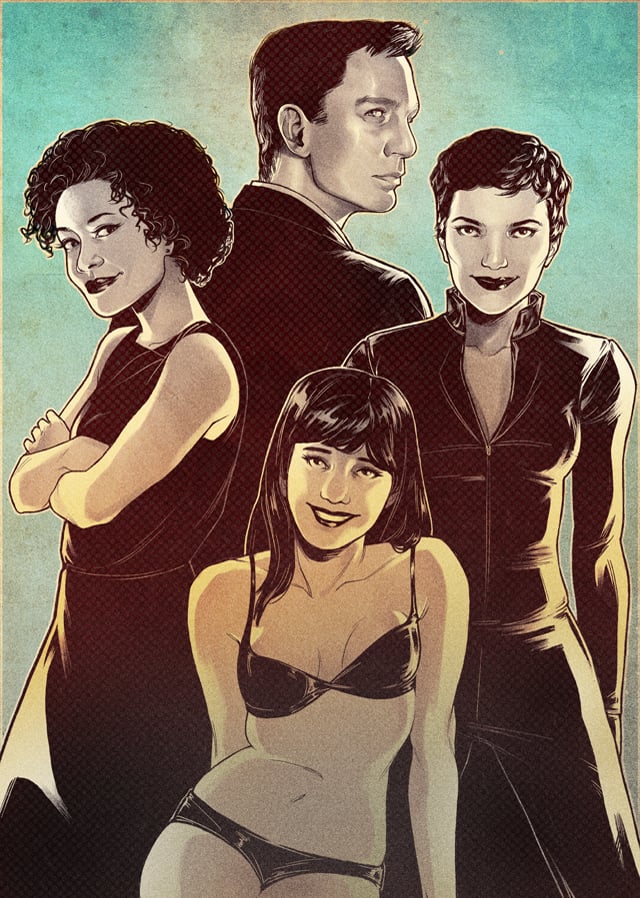





Published: Apr 27, 2015 08:00 pm